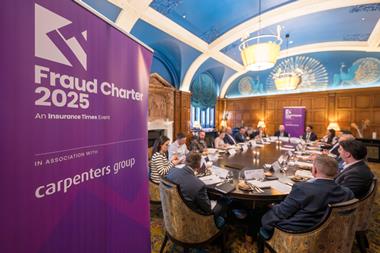Automation in the insurance sector is booming as many businesses continue to invest in digitalisation. Insurance Times asks how the industry can effectively combine technology and a human touch
Peter Blanc, group chief executive, Aston Lark

Whenever we’re working out how best to serve customers, there are two ways of finding out the answer.
The first is pretty obvious – ask them how they would like to be served. The second is also pretty straightforward – put yourself in your customers’ shoes and think about how you would like to be served.
It amazes me how many businesses make decisions about how to service their customers without apparently even considering what customers actually want.
For insurance, the challenge is to find and use technology that genuinely speeds up the process without dumbing it down.
My biggest concern about online insurance sales is that customers don’t know what they don’t know. The overwhelming majority of people need advice when it comes to arranging insurance.
We mustn’t fall into the trap of simplifying the product in order to ‘fit it in’ to the available tech - the outcome will be unpaid claims and a shocking reputation for the insurance profession.
What we have to do instead is use tech to speed up the provision and quality of advice and solutions – speeding up the information gathering phase, improving the quality of decision-making and, ultimately, improving the service delivery. But we must do this with the number one aim of making sure the product is truly fit for purpose.
Highly trained, high quality staff giving great advice in a modern, slick and tech-savvy way – that’s what we’re aiming for.
James Burton, senior director of product management, LexisNexis Risk Solutions

Insurance providers are under more pressure than ever to really understand risks in real-time to deliver fair value in pricing and products, as well as reduce exposure to fraud.
Data, analytics and technology can create a 360 degree view of risk, but it’s human skill that determines the next best action.
Data and technology are enablers. They can streamline the assessment of risk, speed up the delivery of quotes, cut referrals and expedite claims.
It’s about working smarter to automate processes, thereby freeing up time to deliver the human element where it’s most needed to make the right call for the customer.
For example, technology can deliver access to Covid-19 data attributes at quote to identify lockdown-induced motor insurance cancellations or gaps in cover, so that pricing and products can be offered based on the individual’s circumstances.
Tech can also expedite identity validation using email intelligence, passing through good consumers quickly and freeing up resources to investigate fraud and ghost broking. Technology additionally helps identify policyholders at risk in extreme weather events.
Insurance has become more digitised in response to the Covid-19 pandemic, but human touch will always be needed and could prove to be a differentiator as seamless digital customer experiences become the norm.
Chris Hallett, head of special investigations unit, Synectics Solutions

Nobody can deny the power of technology and the impact digital transformation is having on an insurance industry steeped in tradition.
Innovation and technological advancements allow us to capture, analyse and share intelligence across sectors to help enhance the customer experience, bolster service provision and reduce our exposure to risk.
Undoubtedly more prevalent across personal lines, consumers have come to expect a seamless digital experience that is robust enough to protect their own personal data from misuse and fraudulent activity.
In an increasingly competitive environment, it’s essential to differentiate from competitors and this can be done through strong personal engagement, allowing customers to identify with the brand and its proposition.
Cutting-edge technology acts as an enabler, underpinning systems and processes that help to deliver a good service but, ultimately, if those systems falter, it’s the people at the face of the business who will help to drive customer confidence and build brand loyalty.
It’s simple - invest in technology to give businesses structure and insight, but also train people to understand technology’s potential and, importantly, its limitations in an increasingly remote world.

Christina Di Nolfo, head of solutions, Delta Capita
The insurance industry has long deployed technology that has interacted with its customers, whether this be call centres, automated self-service, chatbots or insurance supermarket websites.
However, to some extent, technology has become technology for tech’s sake, forgetting that its raison d’être [most important purpose] should be focused on improving customer satisfaction through the provision of digitally enhanced services - nearly everybody has found themselves arguing with a chatbot or hanging up on a call because the menu for self-service selection provides a labyrinth of choice, leading seemingly to nowhere.
Covid-19 has increased the use of customer service technology, but this has ostensibly only acerbated the existing issue of technology - being self-serving instead of customer-serving.
During a time of isolation and human touch deprivation, bringing the human touch back into the insurance sector is very much needed.
Regulatory requirements which, for example, require a particular focus on vulnerable individuals and those in need, calls for real-time customer intervention and interaction.
Technology that provides the ability to transact, review policies, process claims and sign documents digitally in real-time, securely and all with a compliant audit trail, are industry transforming.
Graham Gibson, chief claims officer, Allianz Insurance

Claims is an area where the alliance between human and machine makes most sense.
To handle a claim efficiently, you need the information gathering power of technology, coupled with data, but also the emotional intelligence of a person.
I like to think of this combination as bionic claims, where the handler’s human capability is augmented by technology.
We already know that image recognition can assess vehicle damage from a few pictures in a matter of seconds and optical character recognition can extract policy numbers, registration numbers and other references from emails and attachments. This type of automation really saves time. By removing data inputting and other mundane tasks, this frees up the handler to focus on the customer.
There are other ways digital technologies make the claims process more user-friendly.
Allianz’s fleet customers can notify their claim via an app and follow its progress online. Brokers can track claims on our claims hub, where they can also contact a handler via live chat.
The guiding principle behind these innovations is that our customers and broker partners have choice - they decide how they prefer to interact with us and when.
We are now exploring process mining tools, giving us a visual representation of claims journeys. This is a good example of technical expertise supporting the continuous improvement of customer experience.
Ranvir Saggu, chief executive, Blocksure
The emergence of embedded, gig economy and microinsurance products is a response to the need for greater accessibility of relevant insurance cover that standard policies are unable to deliver.

While technology is not going to replace important personal connections - which support understanding customer requirements, educating customers on insurance and providing the correct advice on coverage - it is the foundation from which insurance providers can deliver on the changing digital needs of their customers.
Perhaps that is the real innovation. Technology solutions such as a distributed ledger, a system that enables the sharing of data among different participants, supports the dialogue between the insurance industry and the buyer so they can mutually understand their needs and the value of accessible cover and then deliver the solutions that address those needs.
Whether it is a food delivery driver in the UK gig economy or a seaweed farmer in Indonesia, flexible technology and the open dialogue that helps education and awareness are combining to make real inroads to addressing the protection gap.
Simon Lancaster, chief executive, SJL Insurance Services

Although SJL Insurance Services embraces technology and recognises its importance, on both the wholesale broker side and regarding our direct clients, we are well known for our traditional, old school approach where relationships are key.
We marry technology and the human touch by focusing on search engine optimisation (SEO) through our website, bringing us to page one of Google searches for various business insurance products - this delivers a plethora of leads.
We receive requests for quotes online, however rather than an online quote and buy system, these are then responded to by an experienced and qualified insurance executive, who can give the client a consultative approach and use logic and experience to deliver bespoke quotes and advice.
We use the same approach in the MGA arm of the business, with a bespoke binder management IT solution working in tandem with a team of underwriters who review every risk.
This is the same with insurers when obtaining quotes - we use their online quote engines but follow this up with a call for discussion.
You cannot replace the human touch of a great broker and insurance is rarely black and white. Technology is not great with grey areas.
Martin Sarjeant, head of risk solutions management and strategy, insurance at FIS

The Covid-19 pandemic has triggered new risks that will need to be assessed and mitigated, with 78% of insurers identifying an urgent need to upgrade solvency and risk modelling capabilities, according to our recent Readiness Survey, published in June 2021.
Insurers cite that insufficient computing power was a major barrier to enhancing solvency and risk modelling during the pandemic - they are now investing in risk management upgrades to manage pandemic-driven risk challenges.
But while computing power is essential to mitigate these new challenges, firms can’t afford to neglect their human resources – the future of the insurance industry is not one run solely by machines and automation, but one where technology is deployed to enhance the human touch, particularly in those areas that require uniquely human skills.
Insurance has always been a people business. While artificial intelligence (AI) and machine learning (ML) can help predict human behaviour, it takes a human to understand it and act upon it in an adequate manner, especially when dealing with sensitive subjects.
This is why at FIS we stress the importance of no code tools, which democratise AI by making it widely available to business users to help augment human intelligence for better customer-centric products, services and experiences.
Matt McGrillis, chief technology officer, Send

At the intersection of human gut instinct and technology lies excellent underwriting.
While technology is making enormous leaps in saving time and cost, as well as building efficiencies for the industry, we mustn’t lose sight of the fact that underwriting is as much an art as it is a science.
The best underwriters use a highly sophisticated blend of their years of experience, deep professional judgement and carefully crafted skill in addition to available technologies to make assessments on some of the world’s most complex risks, particularly in commercial and specialty lines.
From robotic process automation that takes over mundane, repetitive tasks and AI that rapidly and accurately extracts and harmonises data, to deep learning that spots patterns in data to assist with rating and claims, we can see the potential of technology to revolutionise the insurance industry.
However, these technological innovations must be used to augment and enhance the skills of the underwriter rather than replace them.
The power lies in the fusion of human skill and technology. Openly embracing new technologies may well provide the answer to the challenge many face: how to free up critical resources to focus on what they do best - assessing risks.
Colin Ganson, director, QuestGates
Here at QuestGates, we’ve long taken the view that technology is an enabler to ultimately improving the customer experience, but not at the expense of losing the human touch that is so vital – particularly in the more complex claims where our expertise lies.

One positive to have come out of the Covid-19 pandemic is that it has forced a dramatic acceleration in how we’re all using technology to communicate with our families, colleagues and customers.
People who previously would more than likely have shied away from a video call have become more and more comfortable with them.
Our business believes there is a huge opportunity going forward to take advantage of this new comfort level to deliver greater choice in how our customers communicate with us.
We’re actively pursuing an omnichannel strategy, including developing new tools such as a business WhatsApp, which will allow our customers and our insurer clients to share data more easily and instantly integrate with our own system so that everyone involved in a claim can track progress. It’s all about taking out the hoops that still remain in the process.
Of course, by driving greater efficiencies through automating communications and data gathering, we’ll be freeing up time to help those who prefer face-to-face contact or those vulnerable customers who really need it.
In our view, it’s a win-win for our clients, for our adjusters and, most importantly, for our customers.
Simon Whitmarsh, director, Broking Out Development

I’ve recently started working with a new insurtech called SurveyorTech, which uses a low cost, pay-as-you-go pricing model and has applications across claims, risk management and broking.
SurveyorTech will improve efficiency on claims surveying without removing the human touch and has options for either on-site or remote surveys, all within the same application.
SurveyorTech’s remote application enables claims professionals to invite claimants to a video call, record short videos, capture images and produce a claims report during the call. This will reduce the need for on-site surveys while also reducing costs and the business’ carbon footprint, as well as improving settlement times on smaller claims.
For large losses, SurveyorTech’s on-site functionality enables a claims professional to quickly create a virtual tour of a property, upload videos and floor plans, with the option to create a claims report.
If brokers use this technology pre-loss, it may help them negotiate better terms with underwriters. In the event of a claim, it could reduce investigation times and claims disputes.
All images and videos in the SurveyorTech portal are time, date and GPS stamped to help identify fraud.
Toby MacLachlan, managing director, Ignite Insurance Systems
The insurance industry shouldn’t see technology and human touch as distinct.
Good tech feels very human and goes almost unnoticed. The movement between tech and human interaction, for example online to phone, should be as seamless as possible, so the customer impression is simply of good service, rather than a dichotomy of experience - either human or tech.

Insurance should offer customers a number of options with regards to contact and advice, both human and technology. There is not one solution that fits all.
That said, some channels are more expensive to maintain than others, for example manning phones or using the postal system, and should therefore be charged accordingly so customers who are looking for tech-only interactions can do so and gain maximum benefit without subsidising other routes.












































No comments yet